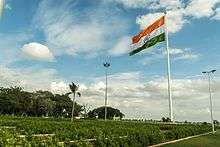Sanjeevaiah Park
| Sanjeevaiah Park సంజీవయ్య ఉద్యానవనము | |
|---|---|
|
A series of Caribbean trumpet trees (Tabebuia aurea) that can be seen at the park
 Indian flag in Sanjeeviah park  Rose garden, Sanjeeviah park | |
| Type | Public park |
| Location | Hyderabad, India |
| Coordinates | 17°23′06″N 78°29′12″E / 17.385044°N 78.486671°ECoordinates: 17°23′06″N 78°29′12″E / 17.385044°N 78.486671°E |
| Area | 92 acres (37 ha)[1] |
| Operated by | Hyderabad Metropolitan Development Authority |
| Status | Open all year |
Sanjeevaiah Park is a public greenspace and park in the heart of Hyderabad, India. Built on 92 acres (37 ha) along the banks of Hussain Sagar lake, the park is named after Damodaram Sanjivayya, an erstwhile Chief Minister of Andhra Pradesh.[2] The park is managed by the Hyderabad Metropolitan Development Authority.[1] The park won the Best Open Landscape Award during the 2010 Indian National Trust for Art and Cultural Heritage award presentations.[3]
Development
The Buddha Purnima Project Authority (BPPA), an agency responsible for the beautification and the upkeep of the areas surrounding the Hussain Sagar lake under Hyderabad Urban Development Authority, planned for several new recreational facilities for public access in 2004. A 2.4 kilometres (1.5 mi) aerial tramway connecting this park to Lumbini Park, which is located on the other side of the Hussain Sagar lake, was planned. Water sports, amusement park and water slides were also the planned activities at the park.[4] A few years later, this proposal by BPPA to convert the park into a recreational area was deemed to be harmful to the park's ecosystem. A study conducted by the regional wildlife advisory board highlighted the need to protect the several species of flora and fauna in the park.[5]
In 2010, Hyderabad Metropolitan Development Authority (HMDA) came up with a new proposal for the park's development. While retaining all the environmental aspects of the park, the agency proposed a plan without construction of any concrete structures. Besides water sports, so as to utilise the huge waterfront, the proposal mooted night illumination, water and energy conservation measures. From their allotted budget of ₹130 million (US$1.9 million) for the lake development, a part of it was to be utilised if this proposal were to be agreed upon by the local government.[1]
Shortly thereafter, solar lighting was installed at the park. Additionally, HMDA also showcased sculptures made from recycled material as a part of its Hyderabad Eco Art Project initiative.[3] Further to this, BPPA also enforced a ban on usage and littering of plastic in several areas including this park. Necessary awareness activities were started to educate the citizens about the hazards of plastic.[6]
Fauna
About 100 species of resident and non-resident birds and more than 50 species of insects and butterflies are present in the park.[7]
The park is frequented by various migratory species of birds. The pied crested cuckoo, which is considered as a harbinger of the monsoon rains due to the timing of its arrival,[8] is frequently spotted at this park. The local birdwatchers predict rains 15–18 days after spotting this bird.[9] Due to construction work initiated by the Hyderabad Metropolitan Development Authority (HMDA), typical birds such as the spotbills, cranes, common coot, purple herons, cormorants and jacanas were not seen at the park in 2010.[10]
Activities
The park hosts several events for the public occasionally. Events ranging from roller-skating races to social awareness campaigns, the park has encouraged public initiatives.[11][12]
Miscellaneous
After the 2007 bombings in Hyderabad, all major parks including this park were put on high security. Owing to this incident, the park witnessed a drastic reduction in the number of visitors.[13]
Gallery
_in_Hyderabad_W_IMG_8148.jpg) Ashy prinia Prinia socialis
Ashy prinia Prinia socialis_in_Hyderabad_W_IMG_8172.jpg) Amaltas Cassia fistula
Amaltas Cassia fistula_in_Hyderabad_W_IMG_8254.jpg) Cattle egret Bubulcus ibis
Cattle egret Bubulcus ibis_calling_in_Hyderabad_W_IMG_8290.jpg) Coppersmith barbet Megalaima haemacephala
Coppersmith barbet Megalaima haemacephala_in_Hyderabad_W_IMG_8167.jpg) Delonix regia Gulmohur
Delonix regia Gulmohur_W_IMG_8217.jpg) Eurasian golden oriole Oriolus oriolus
Eurasian golden oriole Oriolus oriolus_in_Hyderabad_W_IMG_8236.jpg) Vallaris solanacea vish vallari
Vallaris solanacea vish vallari- Purple swamphen Porphyrio porphyrio
 Indian flag in the park
Indian flag in the park Friends having their time
Friends having their time
External links
![]() Media related to Sanjeevaiah Park at Wikimedia Commons
Media related to Sanjeevaiah Park at Wikimedia Commons
References
- 1 2 3 Singh, T. Lalith (10 April 2010). "Plan to develop Sanjeevaiah Park". The Hindu. Retrieved 26 September 2010.
- ↑ "Venue of Rao's cremation has many ironies". Press Trust of India. 25 December 2004.
- 1 2 "Art from recycled material at Sanjeevaiah Park". The Hindu. 27 April 2010. Retrieved 26 September 2010.
- ↑ K, Kaladhar (13 March 2004). "City park to take visitors on a high". The Times of India. Retrieved 26 September 2010.
- ↑ "Park upgradation hits 'eco-block'". The Hindu. 4 August 2007. Retrieved 26 September 2010.
- ↑ "Awareness drive against littering". The Hindu. 15 June 2007. Retrieved 26 September 2010.
- ↑ "BPPA to celebrate World Wetlands Day". The Hindu. 1 February 2008. Retrieved 26 September 2010.
- ↑ Khachar, Shivrajkumar (1989). "Pied Crested Cuckoo Clamator jacobinus – the harbinger of the monsoon". J. Bombay Nat. Hist. Soc. 86 (3): 448–449.
- ↑ Alam, Hina Kumar (2 June 2003). "Monsoon bird spotted in city". The Times of India. Retrieved 26 September 2010.
- ↑ Nanisetti, Serish (2 September 2010). "Save a lake, fill it". The Hindu. Retrieved 26 September 2010.
- ↑ "Sport – Roller-skating". The Hindu. 9 November 2006. Retrieved 26 September 2010.
- ↑ "'Heart 2 Heart' fete spreads laughter". The Hindu. 12 November 2006. Retrieved 26 September 2010.
- ↑ "Security cover for city parks". The Times of India. 28 August 2007. Retrieved 26 September 2010.
_in_Hyderabad_W_IMG_7091.jpg)
_in_AP_W_IMG_3978.jpg)